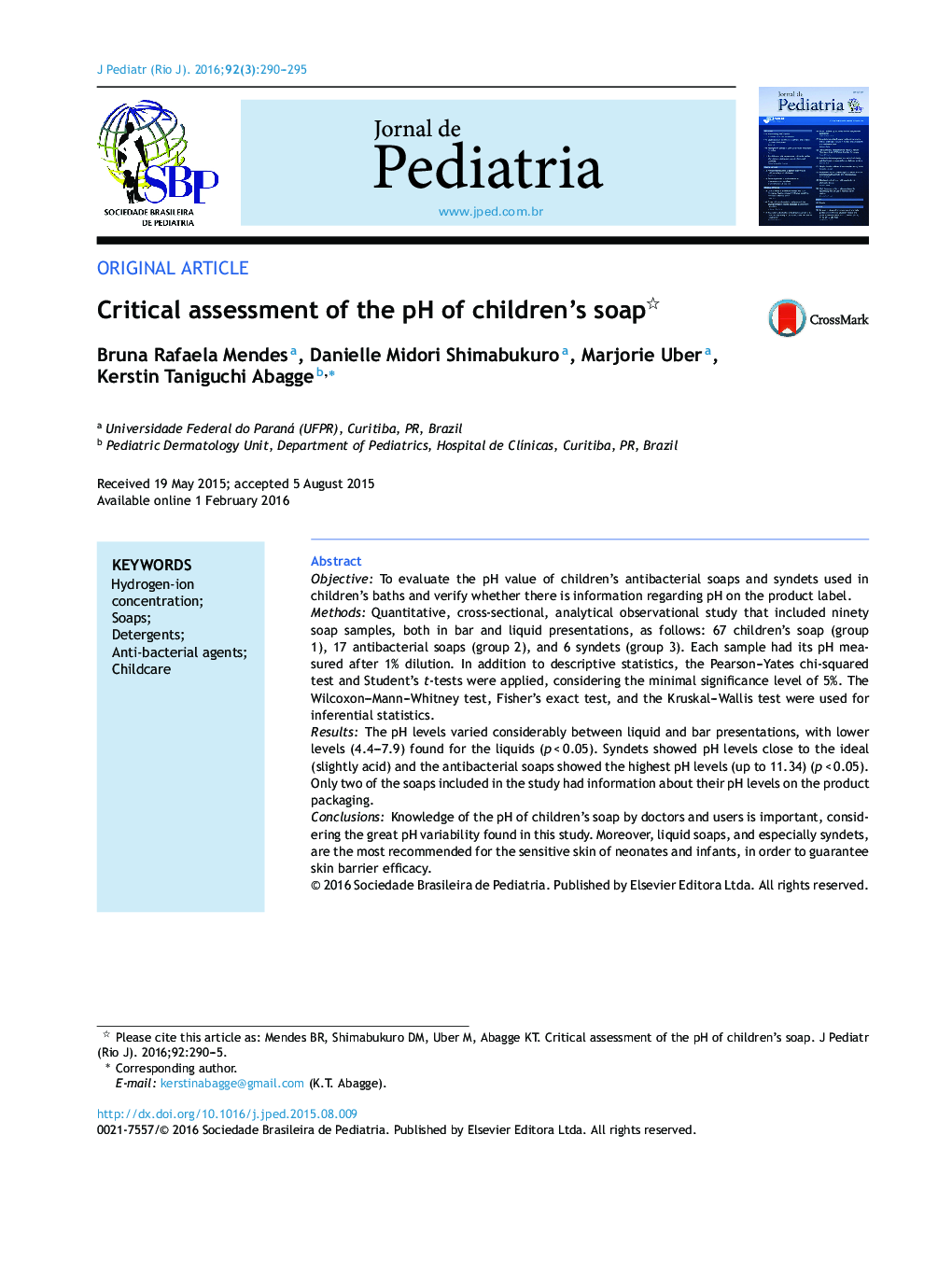| کد مقاله | کد نشریه | سال انتشار | مقاله انگلیسی | نسخه تمام متن |
|---|---|---|---|---|
| 4153776 | 1273674 | 2016 | 6 صفحه PDF | دانلود رایگان |

ObjectiveTo evaluate the pH value of children's antibacterial soaps and syndets used in children's baths and verify whether there is information regarding pH on the product label.MethodsQuantitative, cross-sectional, analytical observational study that included ninety soap samples, both in bar and liquid presentations, as follows: 67 children's soap (group 1), 17 antibacterial soaps (group 2), and 6 syndets (group 3). Each sample had its pH measured after 1% dilution. In addition to descriptive statistics, the Pearson–Yates chi-squared test and Student's t-tests were applied, considering the minimal significance level of 5%. The Wilcoxon–Mann–Whitney test, Fisher's exact test, and the Kruskal–Wallis test were used for inferential statistics.ResultsThe pH levels varied considerably between liquid and bar presentations, with lower levels (4.4–7.9) found for the liquids (p < 0.05). Syndets showed pH levels close to the ideal (slightly acid) and the antibacterial soaps showed the highest pH levels (up to 11.34) (p < 0.05). Only two of the soaps included in the study had information about their pH levels on the product packaging.ConclusionsKnowledge of the pH of children's soap by doctors and users is important, considering the great pH variability found in this study. Moreover, liquid soaps, and especially syndets, are the most recommended for the sensitive skin of neonates and infants, in order to guarantee skin barrier efficacy.
ResumoObjetivosAvaliar o pH dos sabonetes infantis, antibacterianos e sindets habitualmente utilizados em crianças; bem como verificar se há no rótulo desses produtos informação sobre seu pH.MétodosEstudo observacional, analítico, transversal e quantitativo, que incluiu 90 sabonetes nas apresentações em barra e líquida, sendo 67 infantis (grupo 1), 17 antibacterianos (grupo 2) e 6 sindets (grupo 3). Procedeu-se a mensuração do pH das amostras após diluição a 1%. Além da estatística descritiva, foram usados os testes de Qui quadrado Persons/Yates e teste T de Student,com nível de significância mínimo de 5%. Para a estatística inferencial, foram usados os testes de Wilcoxon–Mann–Whitney, exato de Fisher e Kruskal–Wallis.ResultadosO pH variou consideravelmente entre as formas líquida e em barra, com pHs menores (de 4,4 a 7,9) nos líquidos (p < 0,05). Os sindets mostraram pHs próximos ao ideal (levemente ácidos) e os antibacterianos apresentaram os maiores pHs (até 11,34) (p < 0,05). Apenas dois dos sabonetes analisados apresentavam no rótulo a indicação do pH.ConclusõesA observação do pH dos sabonetes infantis pelos médicos e usuários é importante, haja vista a grande variabilidade de valores de pH encontrados. Além disso, os sabonetes líquidos, e especialmente os sindets, são os mais recomendados para uso em recém-nascidos e lactentes com pele sensível, de forma a garantir a eficácia da barreira cutânea.
Journal: Jornal de Pediatria - Volume 92, Issue 3, May–June 2016, Pages 290–295